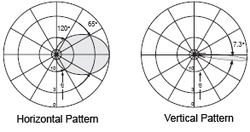Beam tilt
The simplest way is mechanical beam tilt, where the antenna is physically mounted in such a manner as to lower the angle of the signal on one side.More common is electrical beam tilt, where the phasing between antenna elements is tweaked to make the signal go down (usually) in all directions.[1] This is extremely useful when the antenna is at a very high point, and the edge of the signal is likely to miss the target (broadcast audience, cellphone users, etc.)Along with null fill, beam tilt is the essential parameter controlling the focus of radio communications, and together they can create almost infinite combinations of 3-D radiation patterns for any situation.There exists mainly two types of approaches to beam tilt optimization:
AntennasCommon typesDipoleFractalMonopoleSatellite dishTelevisionBlock upconverterCoaxial cableCounterpoise (ground system)Feed lineLow-noise block downconverterPassive radiatorReceiverRotatorTransmitterTwin-leadAntenna farmAmateur radioCellular networkHotspotMunicipal wireless networkRadio masts and towersWirelessWireless device radiation and healthWireless electronic devices and healthInternational Telecommunication UnionRadio RegulationsWorld Radiocommunication ConferenceBoresightFocal cloudGround planeMain lobeNear and far fieldSide lobeVertical planeArray gainDirectivityEfficiencyElectrical lengthEquivalent radiusFactorFriis transmission equationHeightRadiation patternRadiation resistanceRadio propagationRadio spectrumSignal-to-noise ratioSpurious emissionBeam steeringBeamformingSmall cellBell Laboratories LayeredSpace-Time (BLAST)Multiple-input multiple-output (MIMO)ReconfigurationSpread spectrumWideband Space DivisionMultiple Access (WSDMA)horizontal planephasingantennaterrainnull fillcommunicationsradiation patternscoveragecapacityFuzzy LogicContextual BanditReinforcement LearningRadio WorldAnalog televisionbroadcasting topicsSystems180-line343-line375-line405-lineSystem A441-line455-line525-lineSystem M625-lineSystem BSystem CSystem DSystem GSystem HSystem ISystem KSystem LSystem N819-lineSystem ESystem FNTSC-JClear-VisionPALplusBlack levelBlanking levelChrominanceChrominance subcarrierColorburstColor killerColor TVComposite videoFrame (video)Horizontal scan rateHorizontal blanking intervalNominal analogue blankingOverscanRaster scanSafe areaTelevision linesVertical blanking intervalWhite clipperMultichannel television soundSound-in-SyncsZweikanaltonFrequency modulationQuadrature amplitude modulationAntenna (radio)Broadcast transmitterTransmitter stationDifferential gain